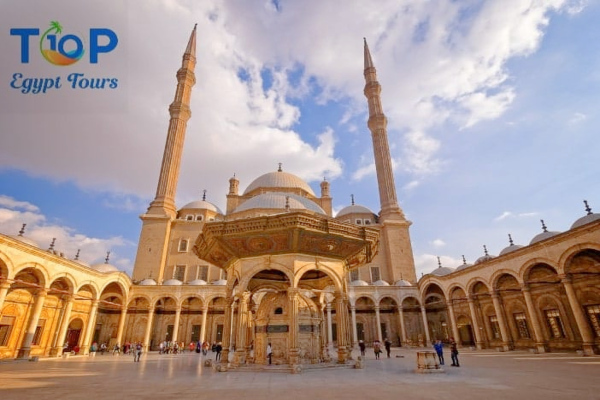Alabaster Mosque of Muhammad Ali, also known as the Alabaster Mosque, is a magnificent religious landmark located in Cairo in Egypt. Built in the 19th century, this mosque is a testament to the rich architectural heritage of Islamic Egypt. In this article. We will explore the captivating features historical context, and cultural significance of the Mosque of Muhammad Ali.
The Mosque of Muhammad Ali, situated on the Citadel of Cairo, is one of the most prominent landmarks in the city. Its imposing structure and intricate details make it a must-visit destination for locals and tourists alike. This article aims to delve into the architectural marvels, historical background, and cultural importance of the Mosque of Muhammad Ali.
In this article, we will uncover for you the Alabaster Mosque of Muhammad Ali with Top Ten Egypt.
Architectural Splendor: A Masterpiece of Islamic Design
Alabaster Mosque of Muhammad Ali, is renowned for its exquisite architectural design. This section will explore the mosque’s structural elements, which include its majestic domes, elegant minarets, and the extensive use of alabaster, which gives the mosque its nickname.
Historical Context: A Gift from Muhammad Ali Pasha
The construction of the Mosque of Muhammad Ali was commissioned by Muhammad Ali Pasha, the ruler of Egypt in the early 19th century. This section will provide historical context, shedding light on the motivations behind the mosque’s construction and its significance as a symbol of Muhammad Ali’s reign.
Cultural Significance: A Center of Worship and Learning
The Mosque of Muhammad Ali holds great cultural and religious importance for the Egyptian people. This section will explore the role of the mosque as a place of worship and its significance as a center for Islamic education and community gatherings. We will also discuss the mosque’s influence on the local community and its contribution to the preservation of Islamic traditions.
Architectural Features Of Alabaster Mosque of Muhammad Ali:
The Mosque of Muhammad Ali is an architectural fusion of Ottoman and Egyptian styles. This section will delve into the unique features that distinguish the mosque, including its Ottoman-inspired domes and minarets, as well as the incorporation of traditional Egyptian elements. We will also discuss the symbolic significance of certain architectural elements within the mosque.
Preservation and Restoration Efforts: Preserving a Cultural Gem
Over the years, the Mosque of Muhammad Ali has undergone various preservation and restoration efforts to maintain its splendor. This section will highlight the initiatives taken to protect the mosque’s architectural integrity and ensure its longevity as a cultural and historical treasure.
Visitor Experience: A Spiritual and Aesthetic Journey
Visiting the Mosque of Muhammad Ali offers a unique and enriching experience. This section will provide practical information for visitors, including details about opening hours, dress codes, and guidelines for respectful behavior. Moreover, it will describe the spiritual and aesthetic journey that visitors can embark upon when exploring the mosque’s grandeur.
Conclusion:
The Mosque of Muhammad Ali, with its striking architecture and rich cultural heritage, stands as a testament to Egypt’s Islamic legacy. It serves as a place of worship, a center of learning, and a symbol of national pride. By exploring its architectural splendor, historical context, and cultural significance, visitors can gain a deeper understanding of Egypt’s vibrant Islamic heritage and appreciate the enduring beauty of the Mosque of Muhammad Ali.



Comment (0)